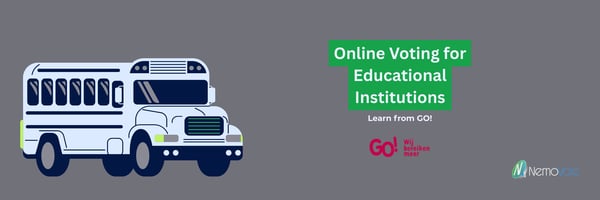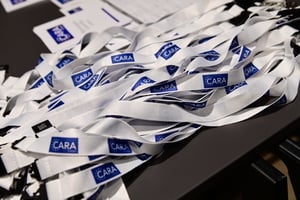A complete guide with practical tips, interview insights, and real success stories from...
How to create a Tender: Step-By-Step Guide on ways to open a bidding.

Chapter
- A short and concise summary
- What is a tender?
- Context of the tender example from practice
- Five steps to a successful tender explained
- Tips for your tender
- Conclusion
- Video: Mastering tenders: Challenges and solutions for tenderers
Short and sweet
The perfect tender is teamwork, starting with the needs analysis and ending with a legally compliant award. Success factor: prepare the process properly, formulate requirements clearly, select providers strategically and react flexibly to new knowledge.
Isabel De Cavel, lawyer, GO! het Gemeenschapsonderwijs:
"The most important investment was time: every hour we spent on preparation saved us work later on."
What is a tender?
A call for tenders is a formal invitation to providers to submit bids for a clearly described service. Public organizations such as GO! in particular must comply with legal requirements in order to ensure transparency and equal treatment.
A precise service description, conditions of participation, deadlines and transparent evaluation criteria are important. The aim is to select the best value for money - but GO! also focuses on the user-friendliness and security of the digital solution.
A distinction is made between a public invitation to tender and a restricted invitation to tender. GO! was able to carry out a restricted invitation to tender due to the volume of the order. The requirements for restricted and public tenders differ depending on the country and organization.
The context of the GO! onderwijs van de Vlaamse Gemeenschap tendering procedure
GO! is an autonomous institution of the Flemish government and organizes the official education system in the Dutch-speaking region of Belgium. With over 1000 schools, 340,000 pupils and around 35,500 employees, GO! is one of the largest educational organizations in Flanders.
"We have many schools and various other educational institutions, which makes coordination complex"
Isabel De Cavel, lawyer, GO! het Gemeenschapsonderwijs:
The digital transformation was long overdue, especially when it comes to digitizing the election processes in school boards.
GO prepared a well documented powerpoint to share with the tenderers to enable a transparent scope for all stakeholders.

1 GO is the flemish (belgium) educational institution with 932 institutions in 26 school groups and 11 types of education. Located in Brussels this picture shows a map with all the GO school groups in belgium


Tendering experiences from the practice of over 1000 schools
Tenders are at the heart of any digital procurement, especially in the education and non-profit sector. A supposedly "bureaucratic" document can make the difference between project success and frustration - and with transparent and smart organizational processes, it can also ensure external trust. In an exchange with Isabel de Cavel, lawyer at GO! onderwijs van de Vlaamse Gemeenschap, it became clear that behind every successful tender is a team that works hand in hand from the needs analysis to the final award.
5 steps to a successful tender
We have seen many tenders, but none have been as structured and well-organized as the GO!
These 5 steps have led to success through structure and can be applied in the future. First things first: Isabel and her team still had to do their homework after school.

1. Needs Analysis – The Foundation
The first and most important step is a joint analysis of needs. Isabel explains:
“We formed a team from different departments – alongside myself as a lawyer, also IT, election organizers from the schools, and project management.”
All requirements were recorded in detail, both functional (e.g., user-friendliness, language) and non-functional (data protection, security).
“The basis is a detailed requirements document that we continually reference.”
Timeline: About one month, 25% or a quarter of the whole process, according to Isabel. However, this depends on the type and volume of the tender.

2. Market Analysis and Selection of Providers – At Least Three Required
After finalizing the list of requirements, GO! took a targeted approach to the market. Most of the research was conducted online. Isabel explains:
“We looked at other public authorities and educational projects that use digital voting systems, but we stayed very focused on our own specific regulations.”
GO! started with about seven potential providers and eliminated those that did not meet essential criteria—such as offering a Dutch-language interface—already in the initial communication phase. The final invitation to submit an offer was sent to three providers—the “legally required minimum,” as Isabel notes.

3. Drafting the Tender: Transparent and Clear Weighting
Based on the developed requirements, the tender was formulated clearly and structured. Isabel explains:
“We disclose exactly how the criteria are weighted—solution quality carried the most weight for us, followed by cost and implementation plan.”
The document specified how the solution needed to function technically, legally, and organizationally, as well as which deadlines had to be met.
4. Dialogue and Evaluation of Providers: Weighted Scoring System
Before the final evaluation, GO! conducted discussions and demo presentations with the vendors.
“It was very important to see the solutions live, to assess usability and understandability for our users,” Isabel notes.
A scoring system was then used to grade all proposals. NemoVote emerged as the clear winner. “We placed great value on a smooth process and on fast, transparent communication with the vendors as well,” Isabel adds.
Evaluation criteria:
1. Price – Third Rule
The cheapest provider received the maximum score; the second cheapest was scored using the formula Points = (lowest offered price / offered price) * maximum score. Thus, depending on how much higher the next price was, the provider received a proportionate share of the points.
2. Fulfillment of requirements
Both functional and non-functional requirements were categorized as must-have, should-have, or could-have. The more criteria fulfilled, the higher the score.
3. References and team
Providers received points if suitable references were available.
4. Implementation plan
Does the provider present a realistic implementation plan for the project? What does the project team look like?
5. Contract & Implementation
After the award, the implementation phase started together. Isabel praises the collaborative partnership with NemoVote:
“We were still able to define individual details together, such as precise terminology or additional features.”
The project team maintained flexibility in terms of time and resources for adjustments, and the timeline for implementation and appropriate development was met in exemplary fashion. Acceptance was already completed in June 2025.
In November 2025, the system will go live at GO! with the first digital school board elections.
Best practice & practical tips for a successful tender
- Invest sufficient time in the needs assessment. "This is the foundation without which you won't get anywhere," says Isabel.
- Form an interdisciplinary team. This is the only way to identify all perspectives and expected requirements at an early stage.
- Communicate openly and transparently throughout the entire tender and project phase.
- Use point-based evaluation systems with clear weighting to make fair and comprehensible decisions.
- Build in sufficient space for feedback and adjustment loops.
Conclusion: Do your homework, be prepared, be successful as a team.
The successful tender at GO! onderwijs van de Vlaamse Gemeenschap is a best-practice example of how teamwork and thorough preparation make digital projects possible in large, complex organizations.
Isabel De Cavel summarizes:
"...you always have to make time for preparation - every hour you invest here saves a lot of effort later on. We are very glad that we took this route."
With clear goals, structured processes and strong partners at your side, every tender is a success. The NemoVote digital voting platform stands for efficient, secure and user-friendly processes - an investment in the future of school organizations.
Mastering tenders: Challenges and solutions for tenderers
If you want to hear the full story of Isabel's tender, check out our podcast:




